Get free scan and check if your device is infected.
Remove it nowTo use full-featured product, you have to purchase a license for Combo Cleaner. Seven days free trial available. Combo Cleaner is owned and operated by RCS LT, the parent company of PCRisk.com.
What kind of software is G-Cleaner?
G-Cleaner (also known as GCleaner) is promoted as an app that supposedly speeds up and optimizes Windows computers. It is promoted as a legitimate application (and its appearance may suggest this) and has a website from which it can be downloaded. In fact, its installation setup also contains a malicious program. G-Cleaner is installed together with AZORult, a trojan-type malicious program.
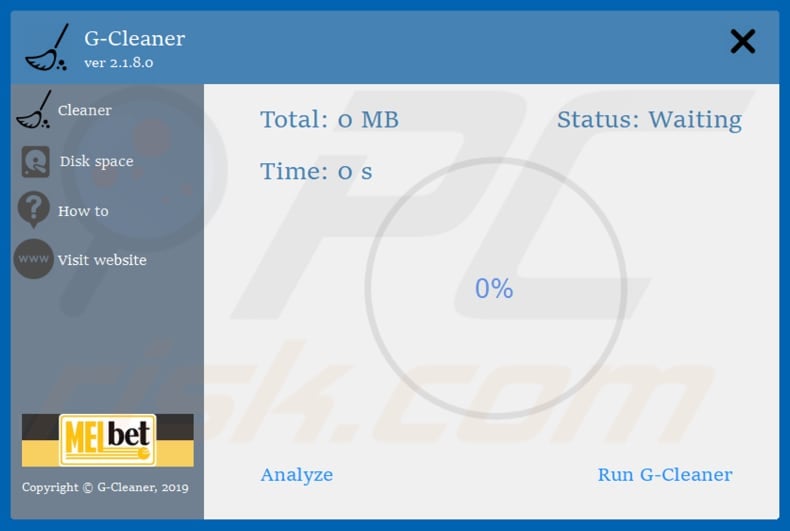
More about G-Cleaner
Developers present G-Cleaner as software that cleans temporary files, broken shortcuts, browsing history, temporary internet files and other 'junk' (unnecessary files). Cleaning up these files supposedly makes Windows systems work faster, however, this is a fake cleaner that is promoted to trick people into installing AZORult.
This Trojan is a program designed to steal sensitive, personal information. It does this by hijacking the web browser and then recording saved passwords and entered data. For example, logins, passwords, cookies, browsing history, etc.
Typically, cyber criminals use the details to steal logins and passwords of crypto wallets or email accounts, XMPP clients, FTP accounts, and so on. Newer versions can be used to take screenshots, record data from Skype, Jabber, and other similar apps.
If a computer is infected with AZORult, cyber criminals can cause serious problems for victims such as financial loss, privacy, browsing safety issues, etc. They use stolen data to generate as much revenue as possible. Therefore, we advise against downloading or installing G-Cleaner.
If it is installed, remove it immediately. Also, the operating system should be scanned for viruses with a reputable anti-virus/anti-spyware suite.
| Name | GCleaner malware |
| Threat Type | Trojan, password-stealing virus, Banking malware, Spyware. |
| Detection Names (SETEU.EXE) | Avast (Win32:Trojan-gen), BitDefender (Gen:Variant.Ursu.421428), ESET-NOD32 (a variant of Win32/Kryptik.GRLH), Kaspersky (Trojan-PSW.Win32.Azorult.lpm), Full List (VirusTotal) |
| Payload | AZORult trojan |
| Symptoms | Trojans are designed to stealthily infiltrate the victim's computer and remain silent. Thus, no particular symptoms are clearly visible on an infected machine. |
| Distribution methods | Infected email attachments, malicious online advertisements, social engineering, software cracks. |
| Damage | Stolen banking information, passwords, identity theft, victim's computer added to a botnet. |
| Malware Removal (Windows) |
To eliminate possible malware infections, scan your computer with legitimate antivirus software. Our security researchers recommend using Combo Cleaner. Download Combo CleanerTo use full-featured product, you have to purchase a license for Combo Cleaner. 7 days free trial available. Combo Cleaner is owned and operated by RCS LT, the parent company of PCRisk.com. |
Apps like G-Cleaner in general
Apps such as G-Cleaner are usually promoted as useful and legitimate, however, they cannot be trusted and should not be downloaded or installed. These apps are used only to generate revenue for the developers by encouraging people to purchase the 'full version' or (in this case) by infecting computers with a Trojan that is programmed to steal personal data/information.
How did G-Cleaner infiltrate my computer?
Apps such as G-Cleaner are often promoted using websites from which they can be downloaded, however, potentially unwanted apps (PUAs) are installed through set-ups of other software as well. Unwanted apps are usually hidden in "Custom", "Advanced" and other settings/options of various (usually free) software download or installation set-ups.
This method is called "bundling", a method that developers use to trick people into installing one software package with another, however, they succeed only if users leave all settings unchanged. PUAs are also installed unintentionally by clicking intrusive ads that download and install them.
How to avoid installation of malware?
Download software from official, trustworthy websites and using direct links. Avoid using third party downloaders, installers, torrents, eMule (or other Peer-to-Peer networks), unofficial websites, and so on. Do not rush software download/installation process and do not leave "Advanced", "Custom" and other options/settings unchecked.
Deselect proposals to download or install unwanted apps and only then proceed to the next step or finish downloading or installing software. Bear in mind that intrusive ads (if clicked) open dubious/untrustworthy websites (gambling, pornography, adult dating, etc.).
Therefore, these ads should not be clicked, however, if they (or redirects) occur randomly check the browser for unwanted extensions, add-ons, plug-ins and remove them immediately. Make sure that there are no unwanted, unknown programs installed on the operating system.
If you believe that your computer is already infected, we recommend running a scan with Combo Cleaner Antivirus for Windows to automatically eliminate infiltrated malware.
Website promoting G-Cleaner unwanted application:
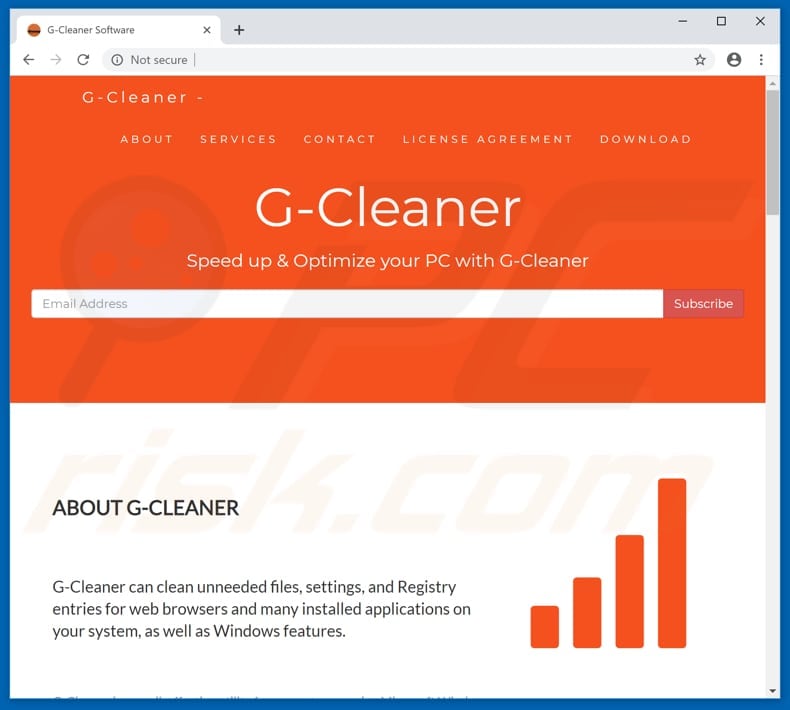
Appearance of G-Cleaner application (GIF):
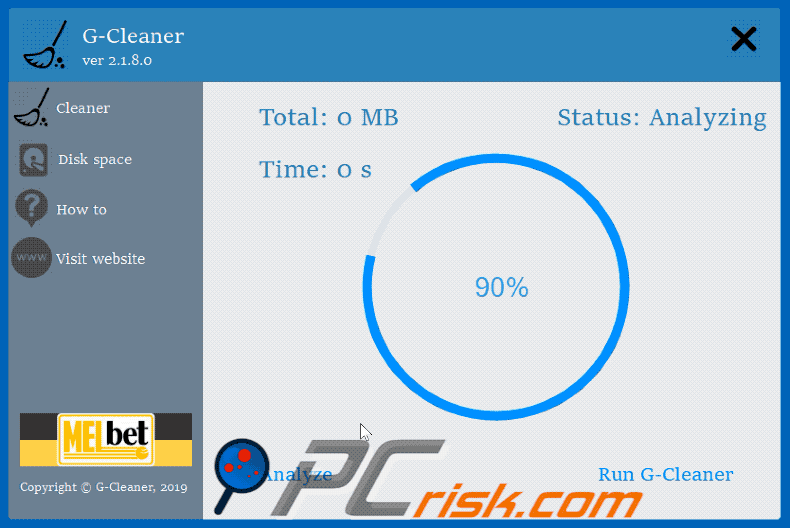
Screenshot of deceptive installer bundling G-Cleaner unwanted application:
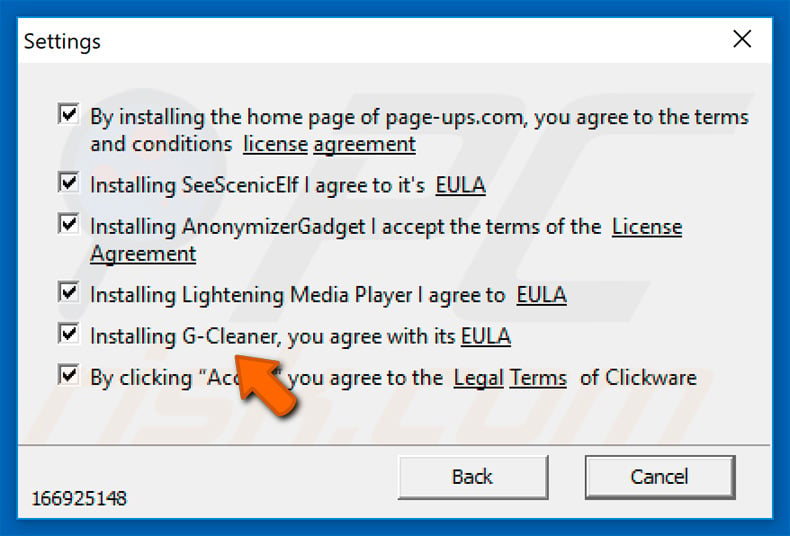
Appearance of GCleaner unwanted application:
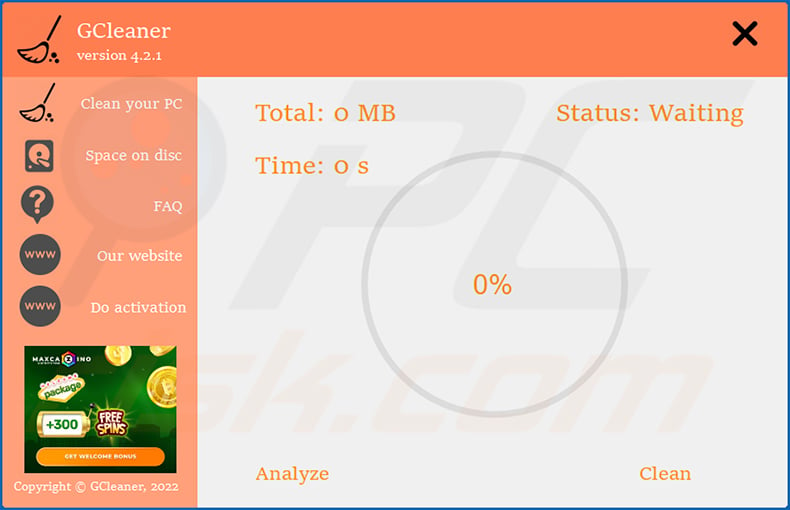
Update March 2nd, 2023 - G-Cleaner has been recently observed being distributed alongside with Stealc stealer, Vidar trojan, RedLine stealer, CryptBot trojan, and a number of other malicious applications.
Instant automatic malware removal:
Manual threat removal might be a lengthy and complicated process that requires advanced IT skills. Combo Cleaner is a professional automatic malware removal tool that is recommended to get rid of malware. Download it by clicking the button below:
DOWNLOAD Combo CleanerBy downloading any software listed on this website you agree to our Privacy Policy and Terms of Use. To use full-featured product, you have to purchase a license for Combo Cleaner. 7 days free trial available. Combo Cleaner is owned and operated by RCS LT, the parent company of PCRisk.com.
Quick menu:
- What is G-Cleaner?
- STEP 1. Manual removal of G-Cleaner and AZORult malware.
- STEP 2. Check if your computer is clean.
How to remove malware manually?
Manual malware removal is a complicated task - usually it is best to allow antivirus or anti-malware programs to do this automatically. To remove this malware we recommend using Combo Cleaner Antivirus for Windows.
If you wish to remove malware manually, the first step is to identify the name of the malware that you are trying to remove. Here is an example of a suspicious program running on a user's computer:

If you checked the list of programs running on your computer, for example, using task manager, and identified a program that looks suspicious, you should continue with these steps:
 Download a program called Autoruns. This program shows auto-start applications, Registry, and file system locations:
Download a program called Autoruns. This program shows auto-start applications, Registry, and file system locations:

 Restart your computer into Safe Mode:
Restart your computer into Safe Mode:
Windows XP and Windows 7 users: Start your computer in Safe Mode. Click Start, click Shut Down, click Restart, click OK. During your computer start process, press the F8 key on your keyboard multiple times until you see the Windows Advanced Option menu, and then select Safe Mode with Networking from the list.

Video showing how to start Windows 7 in "Safe Mode with Networking":
Windows 8 users: Start Windows 8 is Safe Mode with Networking - Go to Windows 8 Start Screen, type Advanced, in the search results select Settings. Click Advanced startup options, in the opened "General PC Settings" window, select Advanced startup.
Click the "Restart now" button. Your computer will now restart into the "Advanced Startup options menu". Click the "Troubleshoot" button, and then click the "Advanced options" button. In the advanced option screen, click "Startup settings".
Click the "Restart" button. Your PC will restart into the Startup Settings screen. Press F5 to boot in Safe Mode with Networking.

Video showing how to start Windows 8 in "Safe Mode with Networking":
Windows 10 users: Click the Windows logo and select the Power icon. In the opened menu click "Restart" while holding "Shift" button on your keyboard. In the "choose an option" window click on the "Troubleshoot", next select "Advanced options".
In the advanced options menu select "Startup Settings" and click on the "Restart" button. In the following window you should click the "F5" button on your keyboard. This will restart your operating system in safe mode with networking.

Video showing how to start Windows 10 in "Safe Mode with Networking":
 Extract the downloaded archive and run the Autoruns.exe file.
Extract the downloaded archive and run the Autoruns.exe file.

 In the Autoruns application, click "Options" at the top and uncheck "Hide Empty Locations" and "Hide Windows Entries" options. After this procedure, click the "Refresh" icon.
In the Autoruns application, click "Options" at the top and uncheck "Hide Empty Locations" and "Hide Windows Entries" options. After this procedure, click the "Refresh" icon.

 Check the list provided by the Autoruns application and locate the malware file that you want to eliminate.
Check the list provided by the Autoruns application and locate the malware file that you want to eliminate.
You should write down its full path and name. Note that some malware hides process names under legitimate Windows process names. At this stage, it is very important to avoid removing system files. After you locate the suspicious program you wish to remove, right click your mouse over its name and choose "Delete".

After removing the malware through the Autoruns application (this ensures that the malware will not run automatically on the next system startup), you should search for the malware name on your computer. Be sure to enable hidden files and folders before proceeding. If you find the filename of the malware, be sure to remove it.

Reboot your computer in normal mode. Following these steps should remove any malware from your computer. Note that manual threat removal requires advanced computer skills. If you do not have these skills, leave malware removal to antivirus and anti-malware programs.
These steps might not work with advanced malware infections. As always it is best to prevent infection than try to remove malware later. To keep your computer safe, install the latest operating system updates and use antivirus software. To be sure your computer is free of malware infections, we recommend scanning it with Combo Cleaner Antivirus for Windows.
Frequently Asked Questions (FAQ)
What is the purpose of an unwanted application?
Typically, applications of this kind are designed are monetized via in-app purchases and (or) intrusive advertisements. Also, they can offer users to pay for their full versions to remove fake viruses, fix fake errors, etc.
Is G-Cleaner unwanted application legal?
In most cases, unwanted applications are considered legal since their End User License Agreements (EULA) typically inform users about the potential behavior. G-Cleaner is promoted as a tool that optimizes the operating system. However, it is distributed alongside AZORult - a Trojan that gathers sensitive information.
Is having G-Cleaner installed on my computer dangerous?
Its installer contains AZORult. This Trojan collects login credentials (e.g., usernames and passwords), cookies, browsing history, etc., from web browsers. Therefore, installing G-Cleaner can lead to problems such as identity theft, monetary loss, loss of access to online accounts, etc.
Will Combo Cleaner help me remove G-Cleaner application?
Yes, Combo Cleaner will scan the operating system and remove G-Cleaner and other unwanted and malicious programs. It is recommended to remove unwanted software automatically to avoid leaving data belonging to unwanted or malicious software in the system.
Share:

Tomas Meskauskas
Expert security researcher, professional malware analyst
I am passionate about computer security and technology. I have an experience of over 10 years working in various companies related to computer technical issue solving and Internet security. I have been working as an author and editor for pcrisk.com since 2010. Follow me on Twitter and LinkedIn to stay informed about the latest online security threats.
PCrisk security portal is brought by a company RCS LT.
Joined forces of security researchers help educate computer users about the latest online security threats. More information about the company RCS LT.
Our malware removal guides are free. However, if you want to support us you can send us a donation.
DonatePCrisk security portal is brought by a company RCS LT.
Joined forces of security researchers help educate computer users about the latest online security threats. More information about the company RCS LT.
Our malware removal guides are free. However, if you want to support us you can send us a donation.
Donate
▼ Show Discussion